Note
Go to the end to download the full example code
Extended Czjzek distribution (Shielding and Quadrupolar)¶
In this example, we illustrate the simulation of spectrum originating from an extended Czjzek distribution of traceless symmetric tensors. We show two cases, an extended Czjzek distribution of the shielding and quadrupolar tensor parameters, respectively.
Import the required modules.
import numpy as np
import matplotlib.pyplot as plt
from mrsimulator import Simulator
from mrsimulator.method.lib import BlochDecaySpectrum, BlochDecayCTSpectrum
from mrsimulator.models import ExtCzjzekDistribution
from mrsimulator.utils.collection import single_site_system_generator
from mrsimulator.method import SpectralDimension
Symmetric shielding tensor¶
Create the extended Czjzek distribution¶
First, create a distribution of the zeta and eta parameters of the shielding tensors using the Extended Czjzek distribution model as follows,
# The range of zeta and eta coordinates over which the distribution is sampled.
z_lim = np.arange(100) * 0.4 + 40 # in ppm
e_lim = np.arange(21) / 20
dominant = {"zeta": 60, "eta": 0.3}
z_dist, e_dist = np.meshgrid(z_lim, e_lim)
_, _, amp = ExtCzjzekDistribution(dominant, eps=0.14).pdf(pos=[z_lim, e_lim])
The following is the plot of the extended Czjzek distribution.
plt.figure(figsize=(4.25, 3.0))
plt.contourf(z_dist, e_dist, amp, levels=10)
plt.xlabel(r"$\zeta$ / ppm")
plt.ylabel(r"$\eta$")
plt.tight_layout()
plt.show()
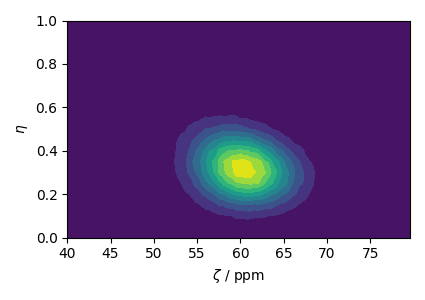
Simulate the spectrum¶
Create the spin systems from the above \(\zeta\) and \(\eta\) parameters.
systems = single_site_system_generator(
isotope="13C", shielding_symmetric={"zeta": z_dist, "eta": e_dist}, abundance=amp
)
print(len(systems))
850
method = BlochDecaySpectrum(
channels=["13C"],
rotor_frequency=0, # in Hz
rotor_angle=0, # in rads
)
Create a simulator object and add the above system.
The following is the static spectrum arising from a Czjzek distribution of the second-rank traceless shielding tensors.
plt.figure(figsize=(4.25, 3.0))
ax = plt.subplot(projection="csdm")
ax.plot(sim.methods[0].simulation.real, color="black", linewidth=1)
plt.tight_layout()
plt.show()
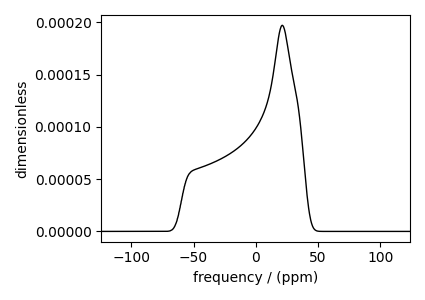
Quadrupolar tensor¶
Create the extended Czjzek distribution¶
Similarly, you may also create an extended Czjzek distribution of the electric field gradient (EFG) tensor parameters.
# The range of Cq and eta coordinates over which the distribution is sampled.
cq_lim = np.arange(100) * 0.1 # assumed in MHz
e_lim = np.arange(21) / 20
dominant = {"Cq": 6.1, "eta": 0.1}
cq_dist, e_dist = np.meshgrid(cq_lim, e_lim)
_, _, amp = ExtCzjzekDistribution(dominant, eps=0.25).pdf(pos=[cq_lim, e_lim])
The following is the plot of the extended Czjzek distribution.
plt.figure(figsize=(4.25, 3.0))
plt.contourf(cq_dist, e_dist, amp, levels=10)
plt.xlabel(r"$C_q$ / MHz")
plt.ylabel(r"$\eta$")
plt.tight_layout()
plt.show()
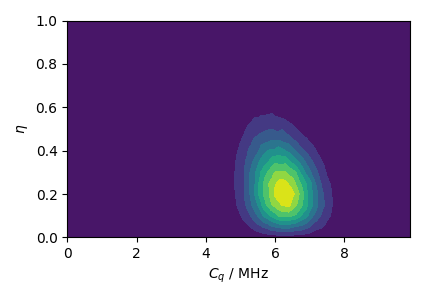
Simulate the spectrum¶
Static spectrum Create the spin systems.
systems = single_site_system_generator(
isotope="71Ga", quadrupolar={"Cq": cq_dist * 1e6, "eta": e_dist}, abundance=amp
)
method = BlochDecayCTSpectrum(
channels=["71Ga"],
magnetic_flux_density=9.4, # in T
rotor_frequency=0, # in Hz
rotor_angle=0, # in rads
spectral_dimensions=[SpectralDimension(count=2048, spectral_width=2e5)],
)
Create a simulator object and add the above system.
The following is a static spectrum arising from an extended Czjzek distribution of the second-rank traceless EFG tensors.
plt.figure(figsize=(4.25, 3.0))
ax = plt.subplot(projection="csdm")
ax.plot(sim.methods[0].simulation.real, color="black", linewidth=1)
ax.invert_xaxis()
plt.tight_layout()
plt.show()
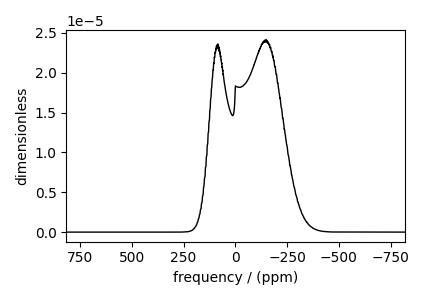
MAS spectrum
mas = BlochDecayCTSpectrum(
channels=["71Ga"],
magnetic_flux_density=9.4, # in T
rotor_frequency=25000, # in Hz
rotor_angle=54.7356 * np.pi / 180, # in rads
spectral_dimensions=[
SpectralDimension(count=2048, spectral_width=2e5, reference_offset=-1e4)
],
)
sim.methods[0] = mas # add the method
sim.config.number_of_sidebands = 16
sim.run()
The following is the MAS spectrum arising from an extended Czjzek distribution of the second-rank traceless EFG tensors.
plt.figure(figsize=(4.25, 3.0))
ax = plt.subplot(projection="csdm")
ax.plot(sim.methods[0].simulation.real, color="black", linewidth=1)
ax.invert_xaxis()
plt.tight_layout()
plt.show()
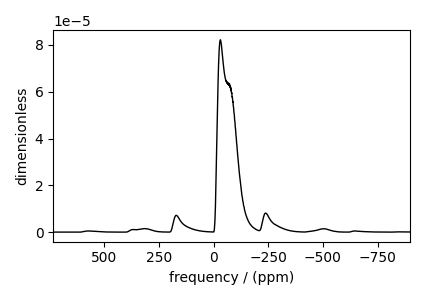
Total running time of the script: (0 minutes 6.952 seconds)
